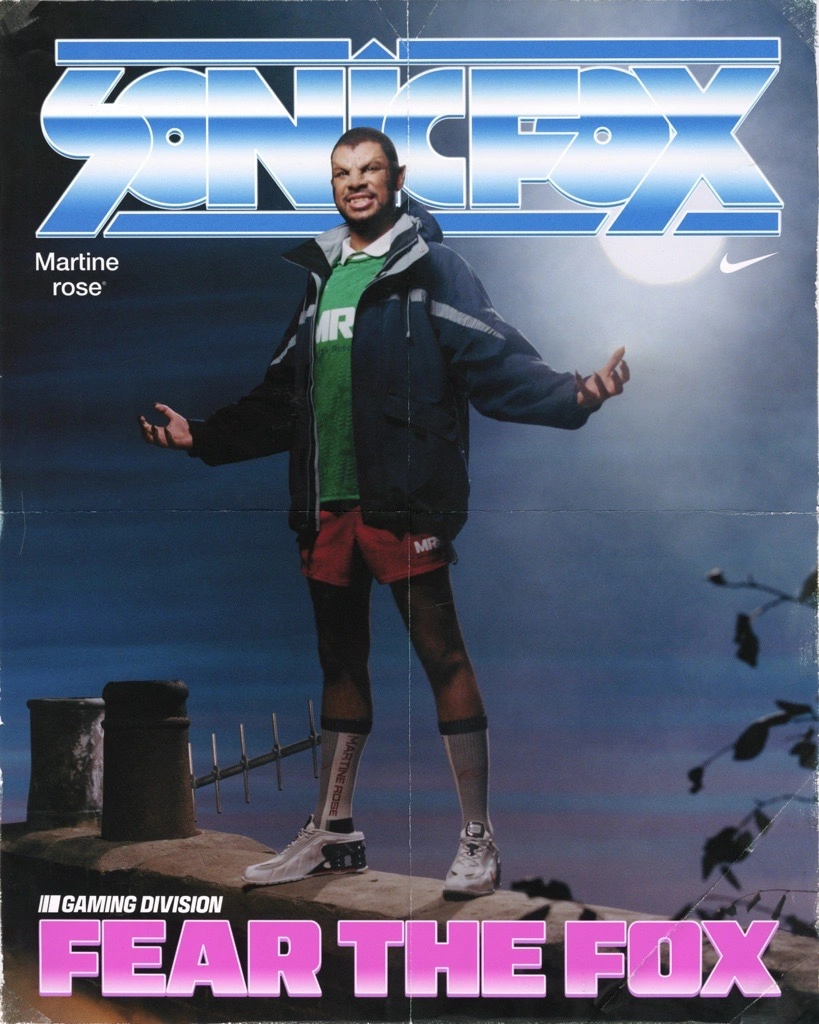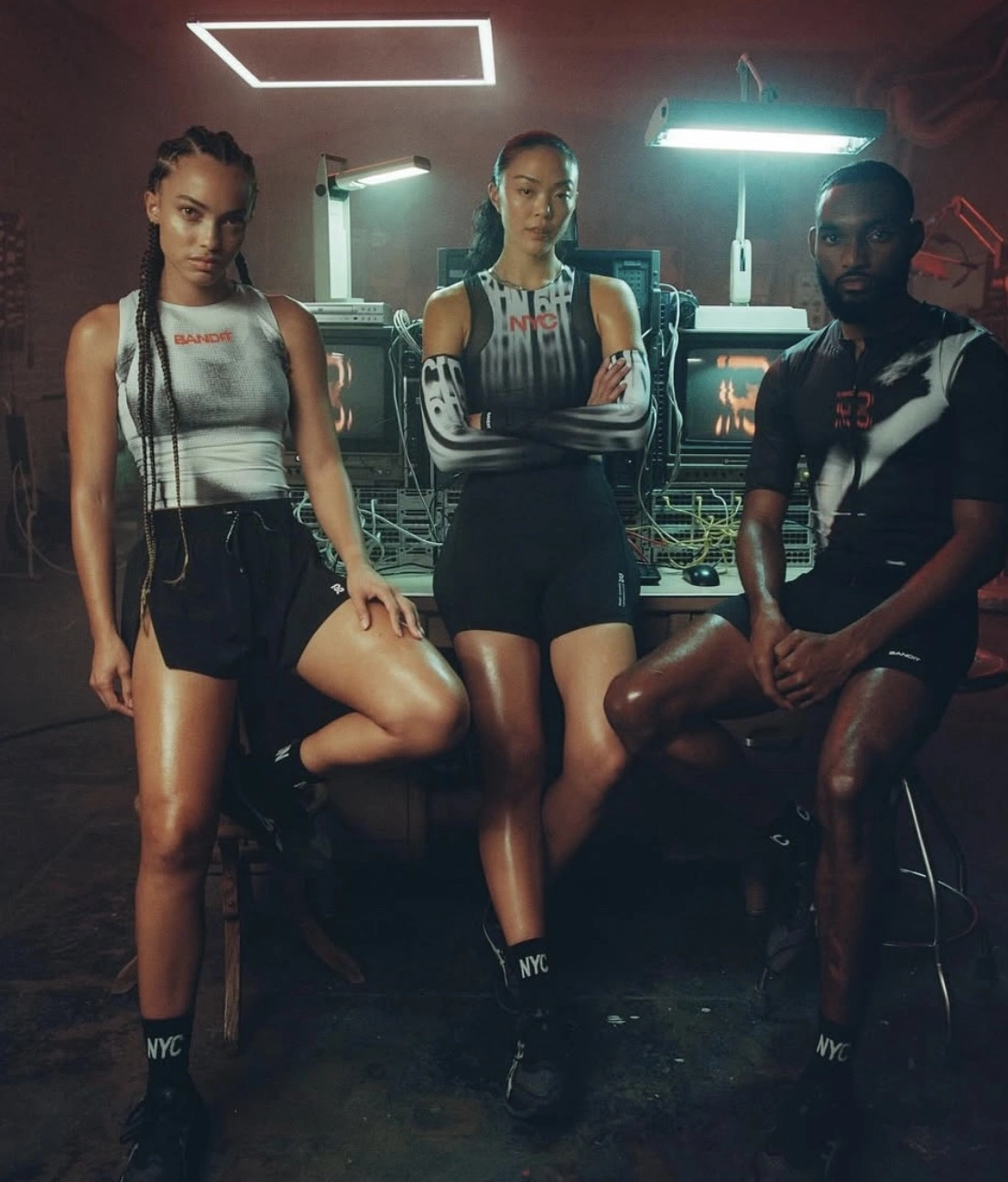When Nike and Martine Rose first collaborated several years ago, the partnership felt like a controlled collision between two distinct universes: the powerhouse of athletic performance and the subversive lens of British street-luxury fashion. Their earlier projects — sharply tailored football kits, surreal reinterpretations of training gear, and the instantly cultish Shox MR4 — revealed a designer who understood sport not as a discipline but as a mirror of identity. Now, in 2025, they return with Sport, a collection that redraws the borders of athleticism itself.
The Nike × Martine Rose Sport collection treats gaming as the new arena of performance, where dexterity, focus, and style define the modern athlete. It’s not about the pitch or the court anymore. It’s about the screen, the controller, the headset, and the expression that lives somewhere between real and virtual. Rose frames gamers as heroes of a contemporary mythology, positioning their digital reflexes and creative agility alongside physical sport’s traditional virtues.
At first glance, the notion of gaming as sport seems almost rhetorical. But in the visual universe Martine Rose and Nike build together, it becomes persuasive, almost inevitable.
the digital athlete
The campaign’s core narrative unfolds around a cast of real esports icons — TenZ, SonicFox, Ana, and Scarlett — photographed like Olympians from another dimension. They appear in football-inspired kits, hoodies, and track jackets, standing against cinematic lighting that feels both sacred and synthetic. Nike calls them “heroes of a modern arena,” a phrase that lands somewhere between manifesto and prophecy.
The staging suggests something essential about contemporary sport: that performance no longer depends on physical exertion alone. The gamer’s posture, their micro-movements, the focused stillness before a match — all of it mirrors the rituals of traditional athletes. The collection transforms that ritual into wardrobe.
Football jerseys become gamer uniforms. Technical fleece becomes the equivalent of a warm-up layer for digital play. Cross-body bags resemble tactical equipment for headsets and controllers. Each piece insists that the discipline of gaming deserves the same aesthetic and material consideration as football, basketball, or running.
For Rose, this isn’t parody or provocation. It’s expansion. She doesn’t question the legitimacy of gaming as sport; she assumes it. The result is a visual argument expressed through fabric and form.
View this post on Instagram
design
The silhouettes of the Sport collection reveal a balance between comfort and control. Heavyweight French terry hoodies, jacquard-knit football shorts, oversized parkas, and pleated track pants form a visual vocabulary that leans equal parts clubwear, pitch, and pixel.
Rose’s instinct for tailoring — honed through years of reshaping men’s formalwear — emerges subtly in seams and cuts. The shoulders are proud, the hems cropped high, the shapes deliberate. There’s ease, but never sloppiness.
Color choices read like a LAN party viewed through rose-tinted nostalgia: neon blues, glitchy purples, and acid greens fade into matte greys and deep blacks. A recurring “MRS” logo runs through the pieces, often paired with a circular globe Swoosh motif, an emblem of the borderless digital world where these athletes live.
Most compelling is the footwear centerpiece — the Shox MR4 Mule. Nike’s famously kinetic cushioning technology reappears under a sharply cut slip-on, its squared toe and elevated heel giving it the tension of a heel yet the comfort of a slide. It feels deliberately hybrid, halfway between sports innovation and subcultural fashion statement.
The mule’s aerodynamic form recalls the speed of avatars and the fluidity of digital movement. Yet its physicality is inescapable: leather, metal, and synthetic mesh fuse into an object that speaks to both runway and esports stage.
gaming, sport, and subculture
Martine Rose has always moved comfortably within the fringes — from underground club scenes to the terraces of British football culture. Her collaborations with Nike carry the same pulse: a fascination with how uniforms shape belonging.
In Sport, she stretches that idea toward the digital. The gamer, too, wears a uniform — not imposed, but invented. Their identity is constructed from avatars, skins, and icons; their presence in the digital arena is performance art. The collection converts that coded language into wearable form.
Hoodies printed with warped graphics mimic the distortion of a screen mid-reload. Parkas echo the oversized protective shells worn by streamers spending hours on stage under harsh lighting. Track pants taper precisely, balancing freedom and structure — the same way a gamer calibrates controls.
At its heart, this collaboration reflects a cultural truth: the distinction between sport, work, and play has dissolved. The young athlete of today might train in the gym, compete online, and perform on social media — all expressions of a single continuum of performance. Nike, always quick to anticipate such shifts, uses Martine Rose’s narrative sensibility to articulate it visually.
a new definition of heroism
What makes Sport resonant is its emotional tone. Nike’s storytelling has long relied on the archetype of the hero athlete overcoming limits. In this collaboration, heroism looks different.
The campaign’s portraits don’t show sweat or struggle in the traditional sense. Instead, they show concentration, interiority, even solitude. Gaming becomes a metaphor for resilience — the ability to focus, to adapt, to perform under unseen pressure.
Rose’s vision embraces this quiet heroism. Her garments amplify individuality without erasing vulnerability. The oversized cuts, the protective layers, the padded collars all communicate security as strength. In this way, Sport connects to broader conversations around mental health, self-expression, and identity in sport culture.
By celebrating gamers as athletes, the collection validates forms of excellence that have long existed outside conventional recognition. For Gen Z and Gen Alpha consumers — who navigate both real and digital worlds fluidly — this redefinition feels overdue.
culture
The collaboration lands at a moment when gaming’s cultural legitimacy has never been higher. Global esports tournaments fill stadiums once reserved for football matches. Streamers command audiences larger than cable networks. Luxury brands host digital pop-ups inside video games.
Nike’s strategy acknowledges this shift not as novelty but as evolution. By declaring gaming part of its “sport continuum,” the brand expands its mission to “move the world forward through sport” into new territory — from turf to server.
For Martine Rose, the project aligns seamlessly with her practice of questioning systems of taste and hierarchy. Where traditional sportwear draws lines between athlete and spectator, her vision blurs them. The gamer, the designer, and the fan occupy the same cultural field. Everyone participates, everyone performs.
The Sport collection thus becomes more than clothing; it’s a thesis about how contemporary culture values performance.
behind the seams
Examining the garments up close, the craftsmanship reveals Nike’s technical precision filtered through Rose’s conceptual lens. Fabrics range from water-resistant shell to double-knit fleece, with ventilation panels and zip placements echoing competitive gear. Even the labels carry coded humor — jock tags that read Player One, digital serial numbers, and heat-transferred graphics resembling circuit paths.
The football jersey, a recurring motif across Rose’s Nike work, evolves here into something both nostalgic and futuristic. Its fitted shoulders and cropped torso reference 1990s kits, while its glossy jacquard weave evokes the shimmer of a gaming screen.
Outerwear draws from Nike ACG archives — particularly a 1997 ski parka — but reinterprets it with asymmetrical zips and translucent overlays, as if the garment itself were caught mid-render.
Every detail gestures toward transformation. These are clothes in flux — between analog and digital, street and sport, spectator and participant.
campaign
Visually, the campaign is hypnotic. Shot by photographer Campbell Addy, it merges high-fashion composition with esports iconography. The lighting imitates the glow of LED rigs; the poses echo both athletes’ readiness and gamers’ introspection.
One image shows SonicFox, their signature blue-fur costume reimagined through Rose’s tailoring, standing like a knight before battle. Another shows TenZ in a parka and shorts, staring into the electric blue void of a screen. The styling is both glamorous and grounded, suggesting that virtual prowess can command the same reverence as physical mastery.
The set design amplifies this mythology: metallic grids, suspended screens, digital smoke. It’s an arena without a crowd, a coliseum of code.
Through these visuals, Nike and Martine Rose make a statement as bold as any slogan: the digital athlete deserves the same stage, the same storytelling, the same apparel that physical sport has enjoyed for decades.
the merging of realities
What the Sport collection articulates most clearly is a philosophy of convergence. The distinction between the physical and digital, between competition and creation, dissolves in its fabrics.
Gamers embody endurance of a different kind: hours of precision, split-second decision-making, emotional control. Nike’s technology — compression fabrics, breathable weaves, ergonomic design — translates those invisible demands into tactile comfort.
Martine Rose contributes a sociocultural dimension: a recognition that identity itself is now a kind of performance. The hoodie becomes armor, the track pant a statement of belonging.
lang
In retrospect, Nike’s collaborations with designers like Martine Rose, Yoon Ahn, and Chitose Abe all point toward the brand’s broader ambition: to redefine what counts as sport in a hybrid world.
Sport stands out because it embraces the paradoxes of our time — competition that happens through screens, communities that gather in pixels, bodies that perform in both flesh and code. It acknowledges that athleticism is evolving faster than the language we have to describe it.
In this light, the Nike × Martine Rose Sport collection reads like a lexicon for the future. Its materials, forms, and narratives form a grammar of hybridity — one where a Shox mule can signify both speed and stillness, where a gamer can wear a football kit and mean it.
fin
As the world of sport stretches toward the virtual, Nike and Martine Rose have produced more than a collection. They’ve produced an argument — that excellence, focus, and style exist wherever performance takes place, whether on the pitch, the screen, or the street.
Their connection blurs not just categories but hierarchies. It positions gamers not as outsiders but as athletes of a different plane, whose skill and creativity deserve celebration. It also reminds us that clothing remains the most immediate interface between self and world, between body and identity.
In Sport, Martine Rose and Nike propose a vision where the arena is everywhere — in the headset’s glow, in the hum of a console, in the flick of a controller, in the quiet determination of a player preparing to compete. It’s a world where style and performance fuse seamlessly, where the hero’s journey continues not on the field but across the screen.
And in that glowing reflection, we begin to see what the future of sport — and perhaps of fashion itself — truly looks like.
No comments yet.








